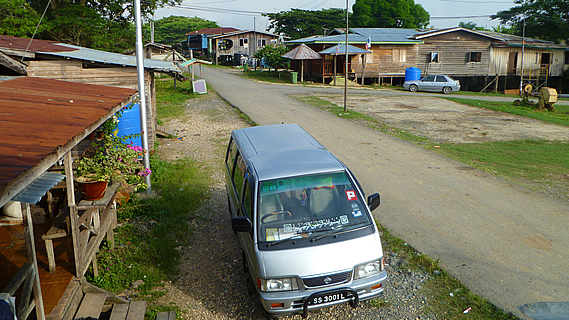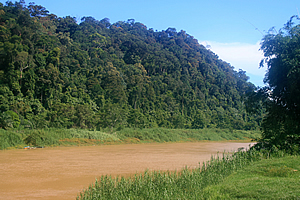--- Archive files ---
Home > Travels > Kinabatangan > 1 |
Village under a Bridge

THE BUS stopped in what seemed to be the middle of nowhere. For several hours we had travelled across the top of Borneo from Ranau at the base of Mount Kinabalu. The terrain throughout the trip had been rugged and mountainous up till half an hour ago when we entered the Kinabatangan Valley, a large river basin.
Much of the countryside we had passed had been cleared of the dense jungle that had once covered the entire island. In recent decades the forest had been replaced by vast farms of palm trees used for the harvest of palm oil to be used in processed foods and cosmetics. This proved to be quite an eye opener.
My tour leader Richard told us we were getting off here in the middle of nowhere. We climbed out of the overly chilled air conditioned bus cabin into the extremely thick equatorial heat to collect our packs. The bus then departed leaving us in a cloud of tropical dust. Once cleared, we left the main road to start walking along an almost parallel side road.
Kinabatangan River |
We were heading towards a small village. Richard had expected us to be picked up here. Perhaps they had forgotten us. Thankfully the village wasn’t far ahead.
After what seemed a long time in the tropical midday heat, but would have really been less than ten minutes, we reached a village. This was the Batu Peteh Community. The main road had by this point risen a good ten metres above the surrounding ground to a large steel suspension bridge crossing the Kinabatangan River.
At this point the river narrowed into a gorge making the erection of a bridge possible. I would later find out this was the only bridge that crosses the river.
The village seemed to be nestled up against the bridge. Perhaps it had initially been established in a natural clearing in the jungle. As tribespeople and explorers travelled through the area, the villages could have established a ferry service allowing travellers to cross the river until the bridge was eventually built.
The village was obviously different now. Gone were the huts built of forest resources. The houses were crudely built from modern processed building materials. They seemed to barely hold themselves together being built from makeshift building materials that could have perhaps fallen off the backs of the trucks that crossed the bridge.
Under the bridge a large volleyball net was set up in between the steel pillars. Perhaps this was to entertain the locals in all weather conditions. On the other side of the bridge stood a new wooden building, an outdoor community area where the locals hosted and entertained the tourists.
We climbed onto the building, taking our shoes off at the steps. It was very well painted with a large mural saying “Selamat Datang. Welcome to Kopel Reception Centre.” There were numerous children here, all of whom approached Richard like a best friend. They were obviously familiar with him from the many tours he had led here in the recent past. The people here were indigenous Orang Sungai, having lived here for thousands of years and seen the conversion of this place from a very remote jungle community to the modern village under the noisy main highway bridge it is now.
Several cooks led us to a large table where we settled amongst the locals and were served lunch. We had a clear view of the dirty brown Kinabatangan River flowing past us appearing somewhat higher than usual. Whilst waiting I went down to a small viewing pagoda from where I could see upstream to a large forested bluff, and downstream through deep healthy grass towards a larger forest. Below me was a small jetty with two small longboats.
|
Here I met my host, Ishak. Richard and I carried our packs across the small village following the uneven dirt road to one of the small houses. Everyone else carried their bags to other houses with their hosts, each to their different homestays. I climbed the stairs and we entered the house, settling into a spare bedroom at the front of the house. The room had two beds. I wondered which of their children here were getting displaced by our stay. The room was unpainted with cheap warped timber panelling lining the walls. The floor was uneven timber and the electrical wiring was very dangerously hanging down the wall from the ceiling. The dangerous tangle of wiring led to the light bulb in the middle of the ceiling, and the small fan on the wall. The room had a single large window at the far end with a thin purple netting curtain bunched together in the middle.
Richard and I entered the lounge. It was now the heat of the early afternoon, so no one had any energy. The entire family was sitting around watching television. The program was some Chinese martial arts movie with Malay subtitles. Obviously they like martial arts movies here. Everyone here was very quiet in the thick heat. Richard had said earlier this morning that the tour groups used to arrive in the late afternoon when everyone was a lot more active. The middle of the day was the siesta and no one had any energy in the equatorial heat.
|
Looking up I saw a large painting of Mecca above the television set. This was the only nice piece of ornamentation in the entire house. Every Muslim household had a picture of Mecca, perhaps as a reminder of the expectation that every man make the pilgrimage once in their lifetime. We had a late lunch here, sitting on the floor eating of cheap plastic plates with no utensils. This was surprisingly primitive for what I was used to. Eating like this was the norm though in Muslim circles.
Although these were indigenous people, at some stage in the past they were reached out by Muslim missionaries who converted them from their traditional animistic ways to modern Islam.
There was a large fish tank to the right of the lounge. On top of this was a series of power boards where I managed to get my batteries charged in preparation for heading out to the eco lodge tonight.
<< Previous | Next >> |
|
||
About this Page
|
||
|
|
|
Where is Walkabout Jeff? |
|
|
|
|
What is happening in Walkabout Jeff's hometown?
|
|
|
|
|
Who is Walkabout Jeff?Any normal person's idea of going out involves going to the local pub for a drink with a few mates. Walkabout Jeff isn't normal.
|
|
|
|
|



